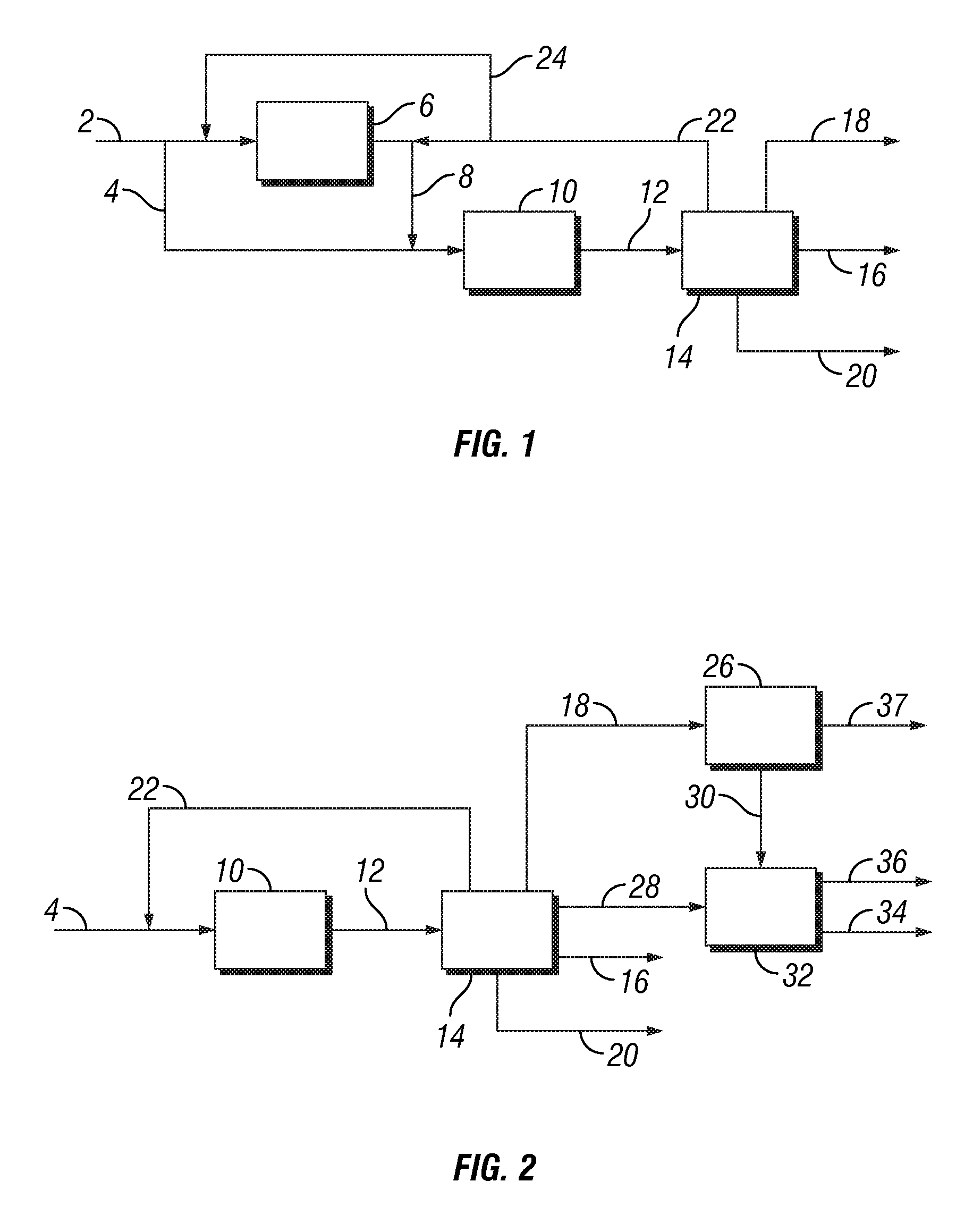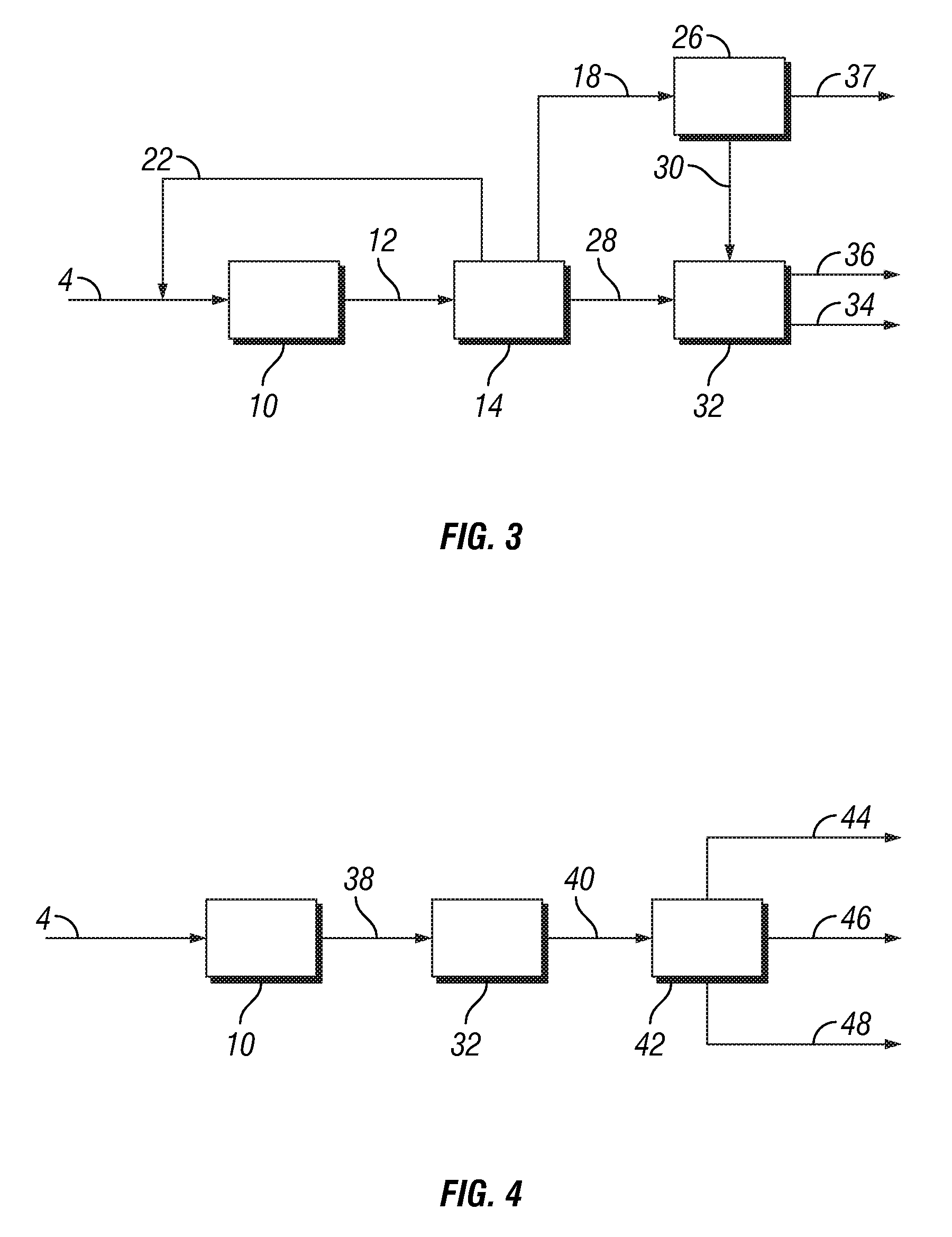Process for the conversion of ethane to mixed lower alkanes to aromatic hydrocarbons
- Summary
- Abstract
- Description
- Claims
- Application Information
AI Technical Summary
Problems solved by technology
Method used
Image
Examples
example 1
[0074]The conceptual example provided below is intended to illustrate but not limit the scope of the invention.
[0075]In this example, ethane is converted into aromatic hydrocarbons in an amount of 3000 tons per day using a process configuration as shown in FIG. 1. Thus, 3000 tons / day ethane stream containing minor amounts of propane, butane and methane shown in stream 2 is divided into two streams. The first stream of about 600 tons / day is introduced into a thermal ethane cracker 6 operated at typical process conditions of about 850° C., 0.3 MPa and steam to hydrocarbon ratio of about 0.3. The resulting product mixture in stream 8, containing about 50% ethylene, 30% ethane and balance being mainly methane and hydrogen is combined with the remaining ethane feed in stream 4 and sent to the ethane to benzene reactor 10. Additionally, a recycle stream 22 in an amount of about 1300 tons / day containing primarily ethane and other components such as ethylene, propane, propylene, methane and...
example 2
[0079]Catalysts A and B were made with low levels of Pt and Ga on extrudate samples containing 80% wt of CBV 2314 ZSM-5 powder (23:1 molar SiO2:Al2O3 ratio, available from Zeolyst International) and 20% wt alumina binder. These catalysts were prepared as described in U.S. Provisional Application No. 61 / 029478, filed Feb. 18, 2008 entitled “Process for the Conversion of Ethane to Aromatic Hydrocarbons.” The extrudate samples were calcined in air up to 650° C. to remove residual moisture prior to use in catalyst preparation. The target metal loadings for catalyst A were 0.025% w Pt and 0.09% wt Ga. The target metal loadings for catalyst B were 0.025% wt Pt and 0.15% wt Ga.
[0080]Metals were deposited on 25-50 gram samples of the above ZSM-5 / alumina extrudate by first combining appropriate amounts of stock aqueous solutions of tetraammine platinum nitrate and gallium(III) nitrate, diluting this mixture with deionized water to a volume just sufficient to fill the pores of the extrudate, ...
example 3
[0091]Using fresh (not previously tested) charges of catalysts A and B described in Example 2 additional performance tests were conducted as described in Example 2 except that the feed consisted of 32.8% w ethane and 67.2% w propane. Table 2 lists the results of online gas chromatographic analyses of samples of the total product streams of these reactors taken at 3 minutes after introduction of the feed. Under these conditions, over 99% wt of the propane in the feed and over 20% w of the ethane in the feed was converted in all of these catalyst performance tests. The product stream contains benzene and higher aromatics, along with hydrogen and light hydrocarbons, including some ethane which can be recycled. Furthermore, it can be seen that only very small amounts of C4 non-aromatic hydrocarbons were produced and no C5 non-aromatic hydrocarbons were produced.
TABLE 2CatalystABBBBACatalyst charge weight, g11.5811.5111.5211.9312.3611.73Reactor Wall Temperature, ° C.650675675675675700Tot...
PUM
| Property | Measurement | Unit |
|---|---|---|
| Temperature | aaaaa | aaaaa |
| Pressure | aaaaa | aaaaa |
Abstract
Description
Claims
Application Information
 Login to View More
Login to View More - R&D
- Intellectual Property
- Life Sciences
- Materials
- Tech Scout
- Unparalleled Data Quality
- Higher Quality Content
- 60% Fewer Hallucinations
Browse by: Latest US Patents, China's latest patents, Technical Efficacy Thesaurus, Application Domain, Technology Topic, Popular Technical Reports.
© 2025 PatSnap. All rights reserved.Legal|Privacy policy|Modern Slavery Act Transparency Statement|Sitemap|About US| Contact US: help@patsnap.com



